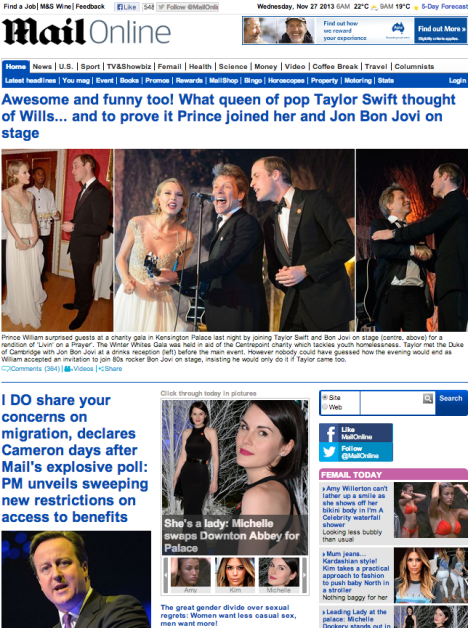You thought Rupert was right wing? You’ve seen nothing yet
 With today’s news the Mail Online is set to launch an Australian arm, Alex Hayes looks at what it means for the local media scene.
With today’s news the Mail Online is set to launch an Australian arm, Alex Hayes looks at what it means for the local media scene.
We could be about to see one of the most exciting periods for Australian journalism there has ever been. But, first, I have one question for you. How much is your house worth?
If you’re ever interviewed by a Daily Mail journalist, be prepared to know the exact market valuation of your two-bedder in Wagga, or they will pop along to a local realtor to get a drive-by estimate, and include the, almost certainly irrelevant fact, in their story.
It’s a tactic known as ‘People like us’ which aims to show make the characters at the centre of some of the bizarre stories the paper digs up as relatable-to as possible for the mainly middle-class housewives who devour the paper every day with glee.
It’s fair to say that’s not the kind of question you see posed by journalists from News, Fairfax or The Guardian every day. But it’s a tactic which plays a large part in making it one of the most powerful media outlets in the UK. It is also the most divisive.
 In the UK the Daily Mail has several nicknames, including the Daily Fail and Daily Fascist. The latter is a passing reference to the paper’s right-wing leanings, constant headlines about asylum seekers, and its sympathetic line to the fascist party in the UK in the 1930s. It’s also famous for predicting that almost everything at one time or another is likely to give you, or help prevent, cancer.
In the UK the Daily Mail has several nicknames, including the Daily Fail and Daily Fascist. The latter is a passing reference to the paper’s right-wing leanings, constant headlines about asylum seekers, and its sympathetic line to the fascist party in the UK in the 1930s. It’s also famous for predicting that almost everything at one time or another is likely to give you, or help prevent, cancer.
It has a newspaper circulation of more than 1.5 million Monday to Friday, second only to Rupert Murdoch’s daily red-top tabloid, The Sun. But whilst The Mail has pretentions of greater things, it is in essence, as one of my English teachers once described it, “a tabloid masquerading as a broadsheet”.
Given this divide and conquer technique it is remarkable the way the website has taken off across the globe, being the most-read English-language news site with 57 million unique visitors per month.
So, what can we expect of dailymail.com.au?
The ‘sidebar of shame’ is perhaps the most well-known section of the site, and certainly what draws most readers in, with tales of which Kardashian has slept with who, and an almost creepy fascination with getting shots of middle-aged celebrities in bikinis on the beach/yachts in the Carribean/south of France. And the Royals.
So, when you add more local scandal, family betrayals and Lara Bingle parading around Bondi in hotpants, it’s fair to assume the site will very quickly grow its million-plus following in Australia, most of whom I would hazard to say are not British.
News Corp’s The Daily Telegraph, Herald Sun and News.com.au would seem the most natural victims of the new beast’s desire to rake in advertising dollars here. Without a paywall, and with greater access to international, and in particularly US celebrity gossip content, Mail Online will appeal to those who like a dose of the scandalous to their coffee break. It is, after all, where most of their Fleet Street rivals look first for the latest gossip.
We’ll probably also see an editorial line even more right-wing than Rupert’s playthings. If you thought you had seen some sensationalist headlines about asylum seekers from our current news offering, you you haven’t seen anything yet.
Whether Fairfax’s audience will be eroded as quickly depends on how the Mail deals with localising content for the metro markets. Even if there is not a large shift away in readership, another major player will definitely eat away at more precious ad dollars.
There is also no secret The Guardian and Mail have not enjoyed the most cordial of relations in the mother country, as ideological opposites. Those ructions are set to spill over down under with Guardian Australia editor Katherine Viner firing the first shots before the press conference had even finished this morning, describing the rivals, perhaps with tongue in cheek, as “copycats” for launching in Australia.
It can hardly be a coincidence they chose six months to the day from The Guardian’s launch to announce their intentions.
The future of the NineMSN site has also been subject of some speculation since Nine split ties with Microsoft in October. What was once the biggest news site in Aus (courtesy of being the logoff screen for Hotmail) is quickly slipping, so it’s no surprise to see a new deal put in place. I suspect we will see the integration of NineMSN quietly into the Mail’s assets, and the moulding of some of its journos into the newsroom as well.
That would certainly make the sales job for what must be a very relieved Mi9 team, anxiously holding on to its Bauer sales remit, that bit easier.
And with Buzzfeed and The Huffington Post both set to wheel out Aussie offspins, the scene is set for the Australian media landscape to become as diverse as it has ever been, eroding the traditional pillars of power, News and Fairfax, quickly. They will both have to think hard to kep up with their more agile counterparts.
It also marks a return to Australia for parent company DMG Media, last seen selling its last 50 per cent share of DMG Radio to Lachlan Murdoch last year, although its DMG Events arm still has a foothold here.
Whatever plays out over the next 12 months it’s clear we’re set to witness one of the more colourful periods of Australian news. As News Corp said after the announcement, “we welcome the competition.”
Alex Hayes, Editor, Mumbrella
- Declaration: I have once been published in The Daily Mail (despite the byline, the story is all mine).




The Daily Mail has not done well re gaining ad revenue, in spite of its claim to be the world’s most-read news site. The year isn’t over yet but guesstimates of the DM’s global ad revenue say that it will finish 2013 with a 59% lift in ad revenue to US$72 million.
Most of this revenue is from the UK and in September MailOnline launched a US$1 million ad campaign in the US – where it boasts 600,000 readers a day – in a bid to attract US advertisers. The campaign is called Seriously Popular – and the text reads – The Kims – They Are On The Same Page and features images of Kim Kardashian and Kim Jong Un.
The main demographic reading MailOnline is not middle-class housewives. Gen Y women aged 25 to 24 account for half its readership. according to AdAge.
Will the Mail Online succeed? Readers will decide, whatever pejorative label Alex Hayes uses to describe the Daily Mail. Me thinks there’s a huge audience for the Mail’s tabloid journalism—far bigger than the Guardian’s audience.
Great piece. I wonder if those who choose to take a daily dose of Kim Kardashian’s bikini will be less excited when they start to see the matter of its editorial ?
I am embarassed to admit it but I visit the Daily Mail about 3 times a week.
I like the sidebar of shame. And I am a lefty pink commie!
Don’t tell anyone – it’s good trash tho
I worked with the founding editor of The Daily Mail as a writer and news executive. We read pieces like this every day in our rivals – usually after we had scooped them!
Decades on, The Mail and now the Mail Online continue to dominate. Even on a world stage.
The strategy is simple to understand but hard to execute: know your readers completely; delivery what they want (and nothing else); do it with professionalism and panache.
Mail Online will do brilliantly in Australia. Expect more hand-ringing pieces about how on earth they stole Australian readers’ hearts…
Just wondering if you felt compelled to announce The Guardian as a lefty rag when its Australian branch came online?
I much prefer The Daily Mash http://www.thedailymash.co.uk/ who have to be mentioned when discussing The Daily Mail.
The Daily Mail already does brilliantly in AU – have a look at the thousands of views of the sidebar of shame during lunch in your office.
Some may not approve but they and The Guardian are the UK papers transcending national borders to become global brands.
As I said before, Fairfax should launch The Age globally if they have any real ambition.